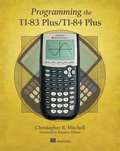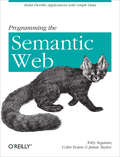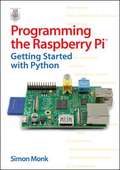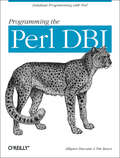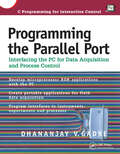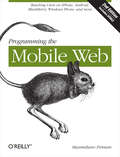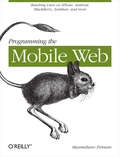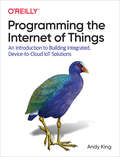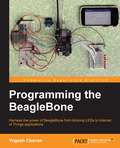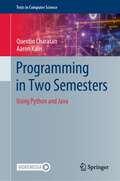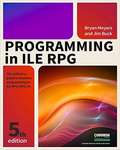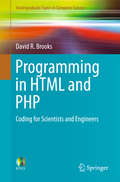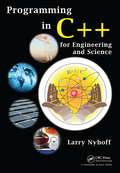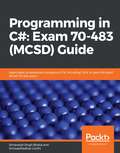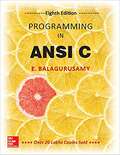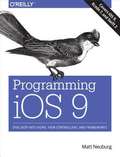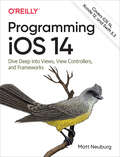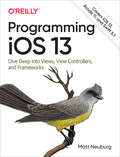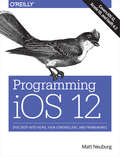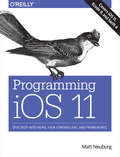- Table View
- List View
Programming the TI-83 Plus/TI-84 Plus
by Christopher MitchellSummaryProgramming the TI-83 Plus/TI-84 Plus is an example-filled, hands-on tutorial that introduces students, teachers, and professional users to programming with the TI-83 Plus and TI-84 Plus graphing calculators. This fun and easy-to-read book immediately immerses you in your first programs and guides you concept-by-concept, example-by-example. You'll learn to think like a programmer as you use the TI-BASIC language to design and write your own utilities, games, and math programs. About the TechnologyThe TI-83 Plus and TI-84 Plus are more than just powerful graphing calculatorst—they are the perfect place to start learning to program. The TI-BASIC language is built in, so you have everything you need to create your own math and science programs, utilities—even games.About the BookProgramming the TI-83 Plus/TI-84 Plus teaches universal programming concepts and makes it easy for students, teachers, and professionals to write programs for the world's most popular graphing calculators. This friendly tutorial guides you concept-by-concept, immediately immersing you in your first programs. It introduces TI-BASIC and z80 assembly, teaches you tricks to slim down and speed up your programs, and gives you a solid conceptual base to explore other programming languages.This book is written for beginners—no programming backgroundis assumed. Purchase of the print book comes with an offer of a free PDF, ePub, and Kindle eBook from Manning. Also available is all code from the book. What's InsideWorks with all models of the TI-83, TI-83+, and TI-84+Learn to think like a programmerLearn concepts you can apply to any languageAdvanced concepts such as hybrid BASIC and ASMTable of ContentsPART 1 GETTING STARTED WITH PROGRAMMINGDiving into calculator programmingCommunication: basic input and outputConditionals and Boolean logicControl structuresTheory interlude: problem solving and debuggingPART 2 BECOMING A TI-BASIC MASTERAdvanced input and eventsPixels and the graphscreenGraphs, shapes, and pointsManipulating numbers and data typesPART 3 ADVANCED CONCEPTS; WHAT'S NEXTOptimizing TI-BASIC programsUsing hybrid TI-BASIC librariesIntroducing z80 assemblyNow what? Expanding your programming horizons
Programming the Semantic Web: Build Flexible Applications with Graph Data
by Toby Segaran Colin Evans Jamie TaylorWith this book, the promise of the Semantic Web -- in which machines can find, share, and combine data on the Web -- is not just a technical possibility, but a practical reality Programming the Semantic Web demonstrates several ways to implement semantic web applications, using current and emerging standards and technologies. You'll learn how to incorporate existing data sources into semantically aware applications and publish rich semantic data.Each chapter walks you through a single piece of semantic technology and explains how you can use it to solve real problems. Whether you're writing a simple mashup or maintaining a high-performance enterprise solution,Programming the Semantic Web provides a standard, flexible approach for integrating and future-proofing systems and data.This book will help you:Learn how the Semantic Web allows new and unexpected uses of data to emergeUnderstand how semantic technologies promote data portability with a simple, abstract model for knowledge representationBecome familiar with semantic standards, such as the Resource Description Framework (RDF) and the Web Ontology Language (OWL)Make use of semantic programming techniques to both enrich and simplify current web applications
Programming the Raspberry Pi: Getting Started with Python
by Simon Monk<P>The Raspberry Pi is rapidly becoming a worldwide phenomena.<P> People are waking up to the possibility of a $35 (U.S.) computer that can be put to use in all sorts of settings--from a desktop workstation to a media center to a controller for a home automation system.
Programming the Perl DBI: Database programming with Perl
by Tim Bunce Alligator DescartesOne of the greatest strengths of the Perl programming language is its ability to manipulate large amounts of data. Database programming is therefore a natural fit for Perl, not only for business applications but also for CGI-based web and intranet applications.The primary interface for database programming in Perl is DBI. DBI is a database-independent package that provides a consistent set of routines regardless of what database product you use--Oracle, Sybase, Ingres, Informix, you name it. The design of DBI is to separate the actual database drivers (DBDs) from the programmer's API, so any DBI program can work with any database, or even with multiple databases by different vendors simultaneously.Programming the Perl DBI is coauthored by Alligator Descartes, one of the most active members of the DBI community, and by Tim Bunce, the inventor of DBI. For the uninitiated, the book explains the architecture of DBI and shows you how to write DBI-based programs. For the experienced DBI dabbler, this book reveals DBI's nuances and the peculiarities of each individual DBD.The book includes:An introduction to DBI and its designHow to construct queries and bind parametersWorking with database, driver, and statement handlesDebugging techniquesCoverage of each existing DBDA complete reference to DBIThis is the definitive book for database programming in Perl.
Programming the Parallel Port: Interfacing the PC for Data Acquisition and Process Control
by Dhananjay GadreWhy purchase expensive add-on cards or bus interfaces when you can develop effective and economical data acquisition and process controls using C programs? Using the under-employed printer adapter (that is, the parallel port of your PC), you can turn your computer into a powerful tool for developing microprocessor applications. Learn how to build a
Programming the Mobile Web: Reaching Users on iPhone, Android, BlackBerry, Windows Phone, and more
by Maximiliano FirtmanWith the second edition of this popular book, you’ll learn how to build HTML5 and CSS3-based apps that access geolocation, accelerometer, multi-touch screens, offline storage, and other features in today’s smartphones, tablets, and feature phones. The market for mobile apps continues to evolve at a breakneck pace, and this book is the most complete reference available for the mobile web.Author and mobile development expert Maximiliano Firtman shows you how to develop a standard app core that you can extend to work with specific devices. This updated edition covers many recent advances in mobile development, including responsive web design techniques, offline storage, mobile design patterns, and new mobile browsers, platforms, and hardware APIs.Learn the particulars and pitfalls of building mobile websites and apps with HTML5, CSS, JavaScript and responsive techniquesCreate effective user interfaces for touch devices and different resolution displaysUnderstand variations among iOS, Android, Windows Phone, BlackBerry, Firefox OS, and other mobile platformsBypass the browser to create native web apps, ebooks, and PhoneGap applicationsBuild apps for browsers and online retailers such as the App Store, Google Play Store, Windows Store, and App World
Programming the Mobile Web
by Maximiliano FirtmanToday's market for mobile apps goes beyond the iPhone to include BlackBerry, Nokia, Windows Phone, and smartphones powered by Android, webOS, and other platforms. If you're an experienced web developer, this book shows you how to build a standard app core that you can extend to work with specific devices. You'll learn the particulars and pitfalls of building mobile apps with HTML, CSS, and other standard web tools.You'll also explore platform variations, finicky mobile browsers, Ajax design patterns for mobile, and much more. Before you know it, you'll be able to create mashups using Web 2.0 APIs in apps for the App Store, App World, OVI Store, Android Market, and other online retailers.Learn how to use your existing web skills to move into mobile developmentDiscover key differences in mobile app design and navigation, including touch devicesUse HTML, CSS, JavaScript, and Ajax to create effective user interfaces in the mobile environmentLearn about technologies such as HTML5, XHTML MP, and WebKit extensionsUnderstand variations of platforms such as Symbian, BlackBerry, webOS, Bada, Android, and iOS for iPhone and iPadBypass the browser to create offline apps and widgets using web technologies
Programming the Internet of Things: An Introduction To Building Integrated, Device-to-cloud Iot Solutions
by Andy KingLearn how to program the Internet of Things with this hands-on guide. By breaking down IoT programming complexities in step-by-step, building-block fashion, author and educator Andy King shows you how to design and build your own full-stack, end-to-end IoT solution--from device to cloud. This practical book walks you through tooling, development environment setup, solution design, and implementation.You'll learn how a typical IoT ecosystem works, as well as how to tackle integration challenges that crop up when implementing your own IoT solution. Whether you're an engineering student learning the basics of the IoT, a tech-savvy executive looking to better understand the nuances of IoT technology stacks, or a programmer building your own smart house solution, this practical book will help you get started.Design an end-to-end solution that implements an IoT use caseSet up an IoT-centric development and testing environmentOrganize your software design by creating abstractions in Python and JavaUse MQTT, CoAP, and other protocols to connect IoT devices and servicesCreate a custom JSON-based data format that's consumable across a range of platforms and servicesUse cloud services to support your IoT ecosystem and provide business value for stakeholders
Programming the BeagleBone
by Yogesh ChavanMaster BeagleBone programming by doing simple electronics and Internet of Things projects About This Book * Quickly develop electronics projects that interact with Internet applications using JavaScript and Python * Learn about electronics components such as sensors and motors, and how to communicate with them by writing programs * A step-by-step guide to explore the exciting world of BeagleBone--from connecting BeagleBone to doing electronics projects and creating IoT applications Who This Book Is For If you want to learn programming on embedded systems with BeagleBone by doing simple electronics projects, this book is for you. This book is also helpful to BeagleBone owners who want to quickly implement small-scale home automation solutions. It is assumed that you have familiarity with C and Python programming. Some familiarity with electronics is helpful but not essential. What You Will Learn * Connect your BeagleBone to a computer in different ways and get the Cloud9 IDE running to quick-start programming on the BeagleBone * Get to know about BeagleBone extension pins such as GPIO and how to connect various electronics components with BeagleBone * Read and write to various electronics components such as LED, Push-button, sensors, and motors * Grasp in-depth theory on Analog, PWM, and BUS programming and the electronics components used in programs * Handle data to and from various BUS supporting modules such as UART, I2C, and SPI using the Adafruit BBIO Python library * Write real-life IoT applications in JavaScript and Python such as shooting an e-mail on overheat and controlling a servo motor remotely * Make use of online free cloud services to store and analyze sensor data collected on the BeagleBone * Discover what else can be done using the BeagleBone * Get to grips with embedded system BUS communication In Detail The whole world is moving from desktop computers to smartphones and embedded systems. We are moving towards utilizing Internet of Things (IoT). An exponential rise in the demand for embedded systems and programming in the last few years is driving programmers to use embedded development boards such as Beaglebone. BeagleBone is an ultra-small, cost-effective computer that comes with a powerful hardware. It runs a full-fledged Debian Linux OS and provides numerous electronics solutions. BeagleBone is open source and comes with an Ethernet port, which allows you to deploy IoT projects without any additions to the board. It provides plenty of GPIO, Anlaog pins, and UART, I2C, SPI pins which makes it the right choice to perform electronics projects. This gives you all the benefits of Linux kernel such as multitasking, multiusers, and extensive device driver support. This allows you to do programming in many languages including high-level languages such as JavaScript and Python. This book aims to exploit the hardware and software capabilities of BeagleBone to create real-life electronics and IoT applications quickly. It is divided into two parts. The first part covers JavaScript programs. The second part provides electronics projects and IoT applications in Python. First, you will learn to use BeagleBone as tool to write useful applications on embedded systems. Starting with the basics needed to set up BeagleBone and the Cloud9 IDE, this book covers interfacing with various electronics components via simple programs. The electronics theory related to these components is then explained in depth before you use them in a program. Finally, the book helps you create some real-life IoT applications. Style and approach An easy-to-follow guide full of real-world electronics programs and quick troubleshooting tips using BeagleBone. All the required electronics concepts are explained in detail before using them in a program and all programs are explained in depth. Most of the theory is covered in the first part; while the second part gives you some quick programs.
Programming in Visual Basic 2010
by Jim MckeownThis is an introduction to programming using Microsoft's Visual Basic. NET 2010, intended for novice programmers with little or no programming experience or no experience with Visual Basic. The text emphasizes programming logic and good programming techniques with generous explanations of programming concepts written from a non-technical point of view. It stresses input, processing, and output and sequence, selection, and repetition in code development. File I/O and arrays are included. Later chapters introduce objects, event programming, and databases. By taking a slow and steady approach to programming ideas, this book builds new concepts from what the reader has already learned. VB tips and quips inject both humor and insight. The book includes numerous programming examples and exercises, case studies, tutorials, and "fixing a program" sections for an in-depth look at programming problems and tools. Quizzes and review questions throughout each chapter get students to think about the materials and how to use them. Each chapter has a summary and glossary for extra review. The accompanying Web site, www.cambridge.org/us/McKeown, has code downloads, I/O, and database files from small, simple files to large files with thousands of records, flowcharts, deskchecks and audits to aid with program design, coding, and debugging; PowerPoint files for every chapter; and hundreds of ideas for programs and projects.<P> Advisory: Bookshare has learned that this book offers only partial accessibility. We have kept it in the collection because it is useful for some of our members. To explore further access options with us, please contact us through the Book Quality link on the right sidebar. Benetech is actively working on projects to improve accessibility issues such as these.
Programming in Two Semesters: Using Python and Java (Texts in Computer Science)
by Quentin Charatan Aaron KansThis highly accessible textbook teaches programming from first principles. In common with many programming courses, it uses Python as the introductory programming language before going on to use Java as the vehicle for more advanced programming concepts. The first part, which teaches Python, covers fundamental programming concepts, such as data types and control structures and functions. It introduces more complex data types such as lists and dictionaries and also deals with file handling. It introduces object-oriented concepts and ends with a case study bringing together all the topics of the first semester. The second part uses Java to teach advanced concepts and centres around object-oriented programming, teaching key object-oriented concepts such as inheritance and polymorphism. The semester again ends with an advanced case study bringing together all the topics of the second semester. Topics and features: Assumes no prior knowledge, and makes the transition from Python to Java a smooth process Features numerous exercises and also an illustrative case study for each language Examines procedural and object-oriented methodologies, as well as design principles Covers such advanced topics as interfaces and lambda expressions, exceptions and Collections Includes a chapter on graphics programming in Python using Tkinter Introduces the latest Java technology for graphical interfaces, JavaFX Explains design concepts using UML notation Offering a gentle introduction to the field and assuming no prerequisite background, Programming in Two Semesters is the ideal companion to undergraduate modules in software development or programming. In addition, it will serve as a strong primer for professionals looking to strengthen their knowledge of programming with these languages.
Programming in ILE RPG, Fifth Edition
by Jim Buck Bryan MeyersSince its original publication, Programming in RPG IV has given thousands of students and professionals a strong foundation in the essentials of business programming using RPG IV. Now, the long-awaited Fifth Edition, retitled Programming in ILE RPG, produces the most significant update to this "gold standard" book in many years. The book has been reorganized and updated to the newest software release. It includes exclusive coverage of free-format RPG, new attention to SQL, and expanded emphasis on ILE modules, procedures, and service programs. All-new programming exercises and assignments add even more value for learning. The book includes complete coverage of the program development process, the newest development tools, RPG IV instructions and operations, creating and using files, program workflow and structured design, arithmetic operations and functions, accessing and updating database files, writing interactive applications, modular programming, service programs, error handling, subfiles, APIs, and more. This book is the one guide you need to learn how to be successful with all aspects of ILE RPG.
Programming in Haskell
by Graham HuttonHaskell is one of the leading languages for teaching functional programming, enabling students to write simpler and cleaner code, and to learn how to structure and reason about programs. This introduction is ideal for beginners: it requires no previous programming experience and all concepts are explained from first principles via carefully chosen examples. Each chapter includes exercises that range from the straightforward to extended projects, plus suggestions for further reading on more advanced topics. The author is a leading Haskell researcher and instructor, well-known for his teaching skills. The presentation is clear and simple, and benefits from having been refined and class-tested over several years. The result is a text that can be used with courses, or for self-learning. Features include: freely accessible powerpoint slides for each chapter; solutions to exercises, and examination questions (with solutions) available to instructors; downloadable code that's fully compliant with the latest Haskell release.
Programming in Haskell
by Graham HuttonHaskell is a purely functional language that allows programmers to rapidly develop clear, concise, and correct software. The language has grown in popularity in recent years, both in teaching and in industry. This book is based on the author's experience of teaching Haskell for more than twenty years. All concepts are explained from first principles and no programming experience is required, making this book accessible to a broad spectrum of readers. While Part I focuses on basic concepts, Part II introduces the reader to more advanced topics. This new edition has been extensively updated and expanded to include recent and more advanced features of Haskell, new examples and exercises, selected solutions, and freely downloadable lecture slides and example code. The presentation is clean and simple, while also being fully compliant with the latest version of the language, including recent changes concerning applicative, monadic, foldable, and traversable types. This new edition has been extensively revised and expanded, including four new chapters as well as many new examples and exercises. Fully compliant with the latest version of Haskell, and updated to include more recent features. An accompanying website provides a range of supporting materials, including PowerPoint slides and Haskell code for the extended examples. <P><P><i>Advisory: Bookshare has learned that this book offers only partial accessibility. We have kept it in the collection because it is useful for some of our members. To explore further access options with us, please contact us through the Book Quality link on the right sidebar. Benetech is actively working on projects to improve accessibility issues such as these.</i>
Programming in Haskell
by Graham HuttonHaskell is a purely functional language that allows programmers to rapidly develop clear, concise, and correct software. The language has grown in popularity in recent years, both in teaching and in industry. This book is based on the author's experience of teaching Haskell for more than twenty years. All concepts are explained from first principles and no programming experience is required, making this book accessible to a broad spectrum of readers. While Part I focuses on basic concepts, Part II introduces the reader to more advanced topics. This new edition has been extensively updated and expanded to include recent and more advanced features of Haskell, new examples and exercises, selected solutions, and freely downloadable lecture slides and example code. The presentation is clean and simple, while also being fully compliant with the latest version of the language, including recent changes concerning applicative, monadic, foldable, and traversable types.
Programming in HTML and PHP
by David R. BrooksThis concise and accessible textbook will enable readers to quickly develop the working skills necessary to solve computational problems in a server-based environment, using HTML and PHP. The importance of learning by example (as opposed to simply learning by copying) is emphasized through extensive use of hands-on exercises and examples, with a specific focus on useful science and engineering applications. The clearly-written text is designed to be simple to follow for the novice student, without requiring any background in programming or mathematics beyond algebra. Topics and features: describes the creation of HTML pages and the characteristics of HTML documents, showing how to use HTML tables, forms, lists, and frames to organize documents for use with PHP applications; explains how to set up a PHP environment, using a local or remote server; introduces the capabilities and syntax of the PHP language, including coverage of array syntax and use; examines user-defined functions in programming, summarizing PHP functions for reading and writing files, viewing the content of variables, and manipulating strings; reviews the PHP GD graphics library, presenting applications for creating pie charts, bar graphs, and line graphs suitable for displaying scientific data; includes appendices listing HTML and ASCII special characters, and highlighting the essential basic strategies for solving computational problems. Supplying all of the tools necessary to begin coding in HTML and PHP, this invaluable textbook is ideal for undergraduate students taking introductory courses in programming. The book will also serve as a helpful self-study text for professionals in any technical field.
Programming in C++ for Engineering and Science
by Larry NyhoffDeveloped from the author's many years of teaching computing courses, Programming in C++ for Engineering and Science guides students in designing programs to solve real problems encountered in engineering and scientific applications. These problems include radioactive decay, pollution indexes, digital circuits, differential equations, Internet addr
Programming in C# (MCSD) Guide: Learn basic to advanced concepts of C#, including C# 8, to pass Microsoft MCSD 70-483 exam
by Simaranjit Singh BhallaThe book is intended to the aspirants of Microsoft certifications and C# developers wanting to become a Microsoft specialist. The book assumes C# knowledge and promises to take it to a practical level.
Programming in Ada 2012
by John BarnesAda 2012 is the latest version of the international standard for the programming language Ada. It is designated ISO/IEC 8652:2012 (E) and is a new edition replacing the 2005 version. The primary goals for the new version were to further enhance its capabilities particularly in those areas where its reliability and predictability are of great value. Many important new features have been included such as those defining dynamic contracts and for handling multiprocessors and are integrated within the existing language framework in an elegant and coherent manner. The Ada 2012 Rationale describes not only the changes from Ada 2005 but also the reason for the changes. It starts with an introduction providing a general overview and this is followed by seven chapters focusing on contracts and aspects; extended expressions; structure and visibility; tasking and real time; iterators and pools; predefined library and containers. The book concludes with an epilogue largely concerned with compatibility issues.
Programming in ANSI C
by E. BalagurusamyAccessible textbook of Programming in ANSI C, eighth edition by E. Balagurusamy. A text book with theoretical and practical approach to learning ANSI C programming with examples and exercises. It contains concepts from elementary to advanced level programming covering critical concepts, such as Arrays, Strings, Functions, Pointers, Self-referential Structures, Dynamic Memory Allocation, etc. which makes this book a great reference guide for the beginners as well as advanced learners.
Programming iOS 5
by Matt NeuburgGet a solid grounding in the fundamentals of Cocoa Touch, and avoid problems during iPhone and iPad app development. With this revised and expanded edition, you'll dig into Cocoa and learn how to work effectively with Objective-C and Xcode. This book covers iOS 5 and Xcode 4.3 in a rigorous, orderly fashion--ideal whether you're approaching iOS for the first time or need a reference to bolster existing skills. Many discussions have been expanded or improved. All code examples have been revised, and many new code examples have been added. The new memory management system--ARC--is thoroughly explained and all code examples have been revised to use it. New Objective-C features, such as declaration of instance variables in the class's implementation section, are described and incorporated into the revised example code. Discussion of how an app launches, and all code examples, are revised for project templates from Xcode 4.2 and later. Other new Xcode features, including the Simulator's Debug menu, are covered, with screen shots based on Xcode 4.2 and later. The discussion of Instruments is expanded, with screen shots--by popular request! Storyboards are explained and discussed. The explanation of view controllers is completely rewritten to include iOS 5 features, such as custom parent view controllers and UIPageViewController. The Controls chapter now includes iOS 5 interface customizability and the appearance proxy. New features of interface classes are discussed, including tiling and animated images, new table view features, new alert view styles. Coverage of frameworks such as Core Motion and AV Foundation is greatly expanded. New iOS 5 classes and frameworks are also discussed, including Core Image and UIDocument (and iCloud support). Important iOS 5 changes that can break existing code are explicitly called out in the text and listed in the index.
Programming iOS 14: Dive Deep Into Views, View Controllers, And Frameworks
by Matt NeuburgIf youâ??re grounded in the basics of Swift, Xcode, and the Cocoa framework, this book provides a structured explanation of all essential real-world iOS app components. Through deep exploration and copious code examples, youâ??ll learn how to create views, manipulate view controllers, and add features from iOS frameworks.Create, arrange, draw, layer, and animate views that respond to touchUse view controllers to manage multiple screens of interfaceMaster interface classes for scroll views, table views, collection views, text, popovers, split views, web views, and controlsDive into frameworks for sound, video, maps, and sensorsAccess user libraries: music, photos, contacts, and calendarExplore additional topics, including files, networking, and threadsStay up-to-date on iOS 14 innovations, such as:Control action closures and menusTable view cell configuration objectsCollection view lists and outlinesNew split view controller architecturePointer customization on iPadNew photo picker and limited photos authorizationReduced accuracy locationColor picker, new page control behavior, revised date pickers, and more!Want to brush up on the basics? Pick up iOS 14 Programming Fundamentals with Swift to learn about Swift, Xcode, and Cocoa. Together with Programming iOS 14, youâ??ll gain a solid, rigorous, and practical understanding of iOS 14 development.
Programming iOS 13: Dive Deep into Views, View Controllers, and Frameworks
by Matt NeuburgIf you’re grounded in the basics of Swift, Xcode, and the Cocoa framework, this book provides a structured explanation of all essential real-world iOS app components. Through deep exploration and copious code examples, you’ll learn how to create views, manipulate view controllers, and add features from iOS frameworks.Create, arrange, draw, layer, and animate views that respondto touchUse view controllers to manage multiple screens of interfaceMaster interface classes for scroll views, table views, text,popovers, split views, web views, and controlsDive into frameworks for sound, video, maps, and sensorsAccess user libraries: music, photos, contacts, and calendarExplore files, networking, and threadsStay up-to-date on iOS 13 innovations, such as:Symbol imagesLight and dark modeSheet presentationDiffable data sources and compositional layoutContext menus and previewsWindow scene delegates and multiple windows on iPadWant to brush up on the basics? Pick up iOS 13 Programming Fundamentals with Swiftto learn about Swift, Xcode, and Cocoa. Together with Programming iOS 13, you’ll gaina solid, rigorous, and practical understanding of iOS 13 development.
Programming iOS 12: Dive Deep into Views, View Controllers, and Frameworks
by Matt NeuburgIf you’re grounded in the basics of Swift, Xcode, and the Cocoa framework, this book provides a structured explanation of all essential real-world iOS app components. Through deep exploration and copious code examples, you’ll learn how to create views, manipulate view controllers, and add features from iOS frameworks.Create, arrange, draw, layer, and animate views that respond to touchUse view controllers to manage multiple screens of interfaceMaster interface classes for scroll views, table views, text, popovers, split views, web views, and controlsDive into frameworks for sound, video, maps, and sensorsAccess user libraries: music, photos, contacts, and calendarExplore additional topics, including files, networking, and threadsStay up-to-date on iOS 12 innovations, such as User Notification framework improvements, as well as changes in Xcode 10 and Swift 4.2. All example code is available on GitHub for you to download, study, and run.Want to brush up on the basics? Pick up iOS 12 Programming Fundamentals with Swift to learn about Swift, Xcode, and Cocoa. Together with Programming iOS 12, you’ll gain a solid, rigorous, and practical understanding of iOS 12 development.
Programming iOS 11: Dive Deep into Views, View Controllers, and Frameworks
by Matt NeuburgIf you’re grounded in the basics of Swift, Xcode, and the Cocoa framework, this book provides a structured explanation of all essential real-world iOS app components. Through deep exploration and copious code examples, you’ll learn how to create views, manipulate view controllers, and add features from iOS frameworks.Create, arrange, draw, layer, and animate views that respond to touchUse view controllers to manage multiple screens of interfaceMaster interface classes for scroll views, table views, text, popovers, split views, web views, and controlsDive into frameworks for sound, video, maps, and sensorsAccess user libraries: music, photos, contacts, and calendarExplore additional topics, including files, networking, and threadsStay up-to-date on iOS 11 innovations, such as:Drag and dropAutolayout changes (including the new safe area)Stretchable navigation barsTable cell swipe buttonsDynamic type improvementsOffline sound file rendering, image picker controller changes, new map annotation types, and moreAll example code (now rewritten in Swift 4) is available on GitHub for you to download, study, and run.Want to brush up on the basics? Pick up iOS 11 Programming Fundamentals with Swift to learn about Swift, Xcode, and Cocoa. Together with Programming iOS 11, you’ll gain a solid, rigorous, and practical understanding of iOS 11 development.
